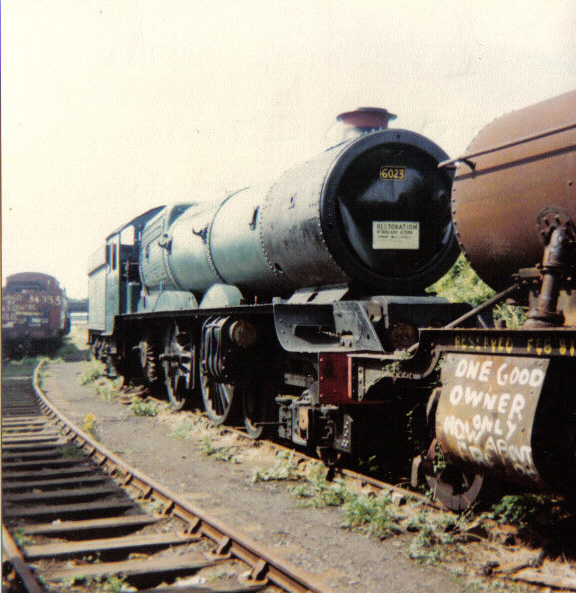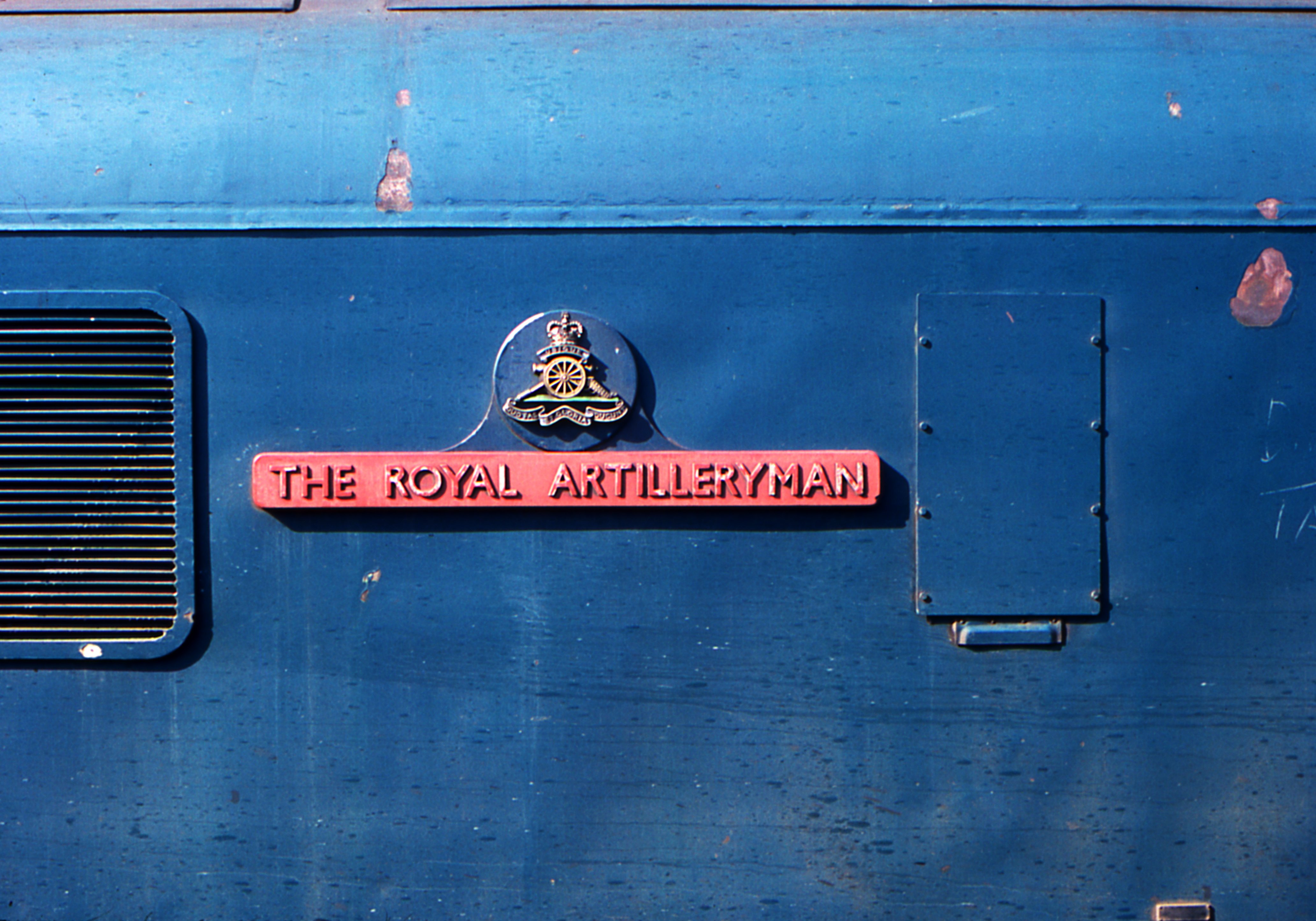|
LMS Ivatt Class 2 2-6-0
The London, Midland and Scottish Railway (LMS) Ivatt Class 2 2-6-0 is a class of steam locomotive designed for light mixed traffic. Design Elderly 0-6-0s formed the backbone of the low-powered locomotives within the LMS fleet. William Stanier had concentrated on introducing larger engines and it was left to George Ivatt to introduce a new class of low-powered locomotive. He designed a tender version of the Ivatt Class 2 2-6-2T, introduced at the same time, which was inspired by the Stanier Class 3 2-6-2T, which was inspired by the Fowler Class 3 2-6-2T. The 2-6-0s had greater range: of water and of coal compared to the tank design's and . So they were well-suited to their task and, following attention to draughting problems by both Derby and Swindon, quickly became a success. Further engines of this type were built as the BR Standard Class 2 2-6-0, these locomotives having BR standard fittings and a modified cab and tender profile to allow completely unrestricted route a ... [...More Info...] [...Related Items...] OR: [Wikipedia] [Google] [Baidu] |
Bristol Harbour Railway
The Bristol Harbour Railway (known originally as the Harbour Railway) was a Standard-gauge railway, standard-gauge industrial railway that served the wharves and docks of Bristol, England. The line, which had a network of approximately of track, connected the Floating Harbour to the Great Western Railway, GWR mainline at Bristol Temple Meads. Freight could be transported directly by waggons to Paddington Station in London. The railway officially closed in 1964. In 1978, a heritage railway named the Bristol Harbour Railway was opened and operated by Bristol Industrial Museum. It uses approximately of the preserved line that runs adjacent to the River Avon, Bristol, River Avon. The line is a very popular visitor attraction in the city. Industrial line The Harbour Railway was a joint venture by the GWR and sister company the Bristol and Exeter Railway. The first part of the network opened in 1872 between Temple Meads and the Floating Harbour. The route required a tunnel under S ... [...More Info...] [...Related Items...] OR: [Wikipedia] [Google] [Baidu] |
Great Western Railway
The Great Western Railway (GWR) was a British railway company that linked London with the southwest, west and West Midlands of England and most of Wales. It was founded in 1833, received its enabling Act of Parliament on 31 August 1835 and ran its first trains in 1838 with the initial route completed between London and Bristol in 1841. It was engineered by Isambard Kingdom Brunel, who chose a broad gauge of —later slightly widened to —but, from 1854, a series of amalgamations saw it also operate standard-gauge trains; the last broad-gauge services were operated in 1892. The GWR was the only company to keep its identity through the Railways Act 1921, which amalgamated it with the remaining independent railways within its territory, and it was finally merged at the end of 1947 when it was nationalised and became the Western Region of British Railways. The GWR was called by some "God's Wonderful Railway" and by others the "Great Way Round" but it was famed as the "Holiday ... [...More Info...] [...Related Items...] OR: [Wikipedia] [Google] [Baidu] |
Barry Scrapyard
Woodham Brothers Ltd is a trading business, based mainly around activities and premises located within Barry Docks, in Barry, South Wales. It is noted globally for its 1960s activity as a scrapyard (hence its colloquial name of Barry Scrapyard), where 297 withdrawn British Railways steam locomotives were sent, from which 213 were rescued for the developing railway preservation movement. History Established in 1892 as Woodham & Sons by Albert Woodham, the company was based at Thomson Street, Barry. The company bought old rope, dunnage wood and scrap metal from the ships, boats and marine businesses which used the newly created Barry Docks, which it then resold or scrapped. Albert retired in 1947, when his youngest son, Dai, was demobbed from the British Army after World War II. Dai renamed the business Woodham Brothers Ltd in 1953, creating four lines of business under four separate companies, which between them employed 200 people: Woodham Brothers, Woodham Transport, Woodham M ... [...More Info...] [...Related Items...] OR: [Wikipedia] [Google] [Baidu] |
BR Class 45
The British Rail Class 45 or Sulzer Type 4 are diesel locomotives built by British Railways' Derby and Crewe Works between 1960 and 1962. Along with the similar Class 44 and 46 locomotives, they became known as ''Peaks''. History The Class 45s became the main traction on the Midland Main Line from 1962, and their introduction allowed considerable acceleration of the previous steam-powered service. The Class 45s remained the main source of power on the Midland Main Line up to 1982, when they were relegated to secondary services following introduction of HSTs on the route. From 1986 Class 45s virtually disappeared from the line. From the early 1980s until their withdrawal c.1988, the class were regular performers on the North Trans-Pennine line working services from Liverpool Lime Street to York, Scarborough or Newcastle via Manchester Victoria, Huddersfield and Leeds. These trains were usually formed of early Mark 2 carriages, of up to seven in a typical train. Naming 2 ... [...More Info...] [...Related Items...] OR: [Wikipedia] [Google] [Baidu] |
YouTube
YouTube is a global online video platform, online video sharing and social media, social media platform headquartered in San Bruno, California. It was launched on February 14, 2005, by Steve Chen, Chad Hurley, and Jawed Karim. It is owned by Google, and is the List of most visited websites, second most visited website, after Google Search. YouTube has more than 2.5 billion monthly users who collectively watch more than one billion hours of videos each day. , videos were being uploaded at a rate of more than 500 hours of content per minute. In October 2006, YouTube was bought by Google for $1.65 billion. Google's ownership of YouTube expanded the site's business model, expanding from generating revenue from advertisements alone, to offering paid content such as movies and exclusive content produced by YouTube. It also offers YouTube Premium, a paid subscription option for watching content without ads. YouTube also approved creators to participate in Google's Google AdSens ... [...More Info...] [...Related Items...] OR: [Wikipedia] [Google] [Baidu] |
Great Central Railway (heritage Railway)
The Great Central Railway (GCR) is a heritage railway in Leicestershire, named after the company that originally built this stretch of railway. It runs for between the town of Loughborough and a new terminus in the north of Leicester. It has period signalling, locomotives and rolling stock. The GCR is currently the only double track mainline heritage railway in the world with of working double track. Four stations are in operation, each restored to a period in the railway's commercial history: (the 1950s); Quorn & Woodhouse (Second World War and the remainder of the 1940s); (Edwardian Era); Leicester North (the 1960s). Background history In 1897, the Great Central Railway itself was formed, becoming the last steam mainline in the United Kingdom. Two years later in 1899, "The London Extension" was officially opened to passenger and freight traffic, allowing more direct journeys from the capital to Nottingham, Leicester, Sheffield and Manchester. The entire line w ... [...More Info...] [...Related Items...] OR: [Wikipedia] [Google] [Baidu] |
Quorn And Woodhouse Railway Station
Quorn and Woodhouse railway station is a heritage station on the Great Central Railway (preserved) serving Quorn & Woodhouse in Leicestershire. Travelling south from Loughborough, it is the first station that is reached. Here there is a large station yard which is suitable for parking. There is also disabled access through the yard (Loughborough now has a lift for disabled as well as access via stairs). Quorn is laid out to appear as it would in the 1940s, as a typical rural LNER station. The signal box is not original but was taken from Market Rasen. The station is grade II listed and has a number of attractions, including the 1940s era NAAFI Tea Room situated underneath the station road bridge, a period Station Master's office, as well as wartime films showing in one of the waiting rooms. In 2011, a new café called ''Butler-Henderson Tea Rooms'' was opened; the building, whilst not in keeping with the station itself, complements its surroundings and provides another reason t ... [...More Info...] [...Related Items...] OR: [Wikipedia] [Google] [Baidu] |
Western Region Of British Railways
The Western Region was a region of British Railways from 1948. The region ceased to be an operating unit in its own right on completion of the "Organising for Quality" initiative on 6 April 1992. The Region consisted principally of ex- Great Western Railway lines, minus certain lines west of Birmingham, which were transferred to the London Midland Region in 1963 and with the addition of all former Southern Railway routes west of Exeter, which were subsequently rationalised. History When British Railways was created at the start of 1948, it was immediately subdivided into six Regions, largely based upon pre-nationalisation ownership. The Western Region initially consisted of the former Great Western Railway system, totalling 3,782 route miles and with its headquarters at Paddington. To this was added some minor railways and joint lines in which the GWR had an interest: *Brynmawr and Western Valleys Railway *Clifton Extension Railway * Easton and Church Hope Railway *Great ... [...More Info...] [...Related Items...] OR: [Wikipedia] [Google] [Baidu] |
North Eastern Region Of British Railways
The North Eastern Region was a region of British Railways from 1948, whose operating area could be identified by the orange signs and colour schemes that adorned its stations and other railway buildings. It was merged with the Eastern Region in 1967. It was the near direct post-nationalisation descendant of the North Eastern Railway, that had merged with some other companies to form the LNER in 1923. In 1958 in a major re-drawing of the region boundaries it gained those former LMS lines that lay in the present-day West and North Yorkshire. In 1967 it was disbanded and merged with the Eastern Region. The Network The region's trunk routes comprised several important lines. Principal among these was the northernmost portion of the East Coast Main Line in England which ran northwards from Doncaster to Marshall Meadows Bay at the Scottish Border where the route became the responsibility of the Scottish Region. The eastern section of the Trans-Pennine route, Hull to Leeds, a ... [...More Info...] [...Related Items...] OR: [Wikipedia] [Google] [Baidu] |
Eastern Region Of British Railways
The Eastern Region was a region of British Railways from 1948, whose operating area could be identified from the dark blue signs and colour schemes that adorned its station and other railway buildings. Together with the North Eastern Region (which it absorbed in 1967), it covered most lines of the former London and North Eastern Railway, except in Scotland. By 1988 the Eastern Region had been divided again into the Eastern Region and the new Anglia Region, with the boundary points being between and , and between and . The region ceased to be an operating unit in its own right in the 1980s and was wound up at the end of 1992. History The region was formed in at nationalisation in 1948, mostly out of the former Great Northern, Great Eastern and Great Central lines that were merged into the LNER in 1923. Of all the "Big Four" pre-nationalisation railway companies, the LNER was most in need of significant investment. In the immediate post-war period there was a need to rebuild ... [...More Info...] [...Related Items...] OR: [Wikipedia] [Google] [Baidu] |








